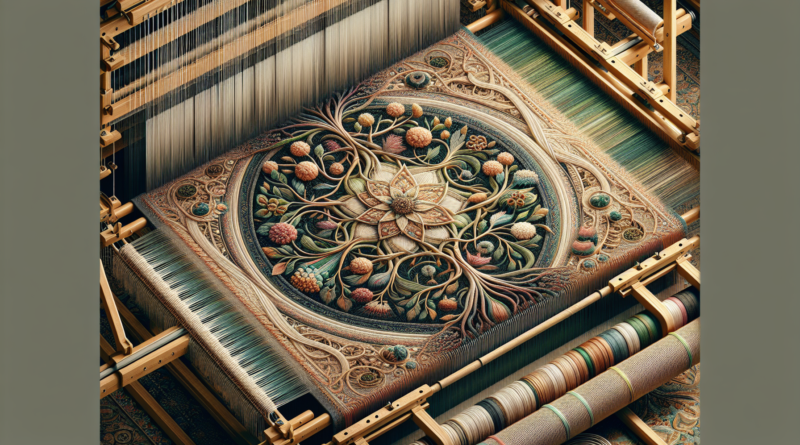Zero-Waste Weaving
Imagine a world where artistry and environmental sustainability converge. Welcome to the world of zero-waste weaving. This unique craft combines the age-old technique of weaving with the modern concept of zero waste, resulting in beautifully intricate textiles that leave no trace on the planet. By utilizing every last bit of fabric and repurposing materials that would otherwise go to waste, zero-waste weavers are not only creating stunning pieces of art but also making a profound impact on the planet. In this article, we will explore the fascinating world of zero-waste weaving, its techniques, and the artists who are pushing the boundaries of sustainability in the textile industry. Get ready to be inspired and amazed by the beauty that can be created when creativity meets eco-consciousness.
Zero-Waste Weaving

What is Zero-Waste Weaving?
Zero-Waste Weaving is a sustainable weaving technique that aims to minimize or eliminate textile waste during the weaving process. Traditional weaving methods often result in significant fabric waste, which contributes to environmental degradation. Zero-Waste Weaving utilizes innovative patterns and techniques to ensure that every piece of fabric is used efficiently, reducing the overall environmental impact of the textile industry.
Benefits of Zero-Waste Weaving
Zero-Waste Weaving offers numerous benefits, both for individuals and the environment. By minimizing fabric waste, this weaving technique reduces the use of valuable resources such as water, energy, and raw materials. It also decreases the pollution and carbon emissions associated with textile production and disposal. Additionally, zero-waste weaving promotes creativity and innovation by challenging weavers to think outside the box and find new ways to utilize every inch of fabric.
Materials Used in Zero-Waste Weaving
Zero-Waste Weaving utilizes a variety of textile materials, including natural fibers such as cotton, linen, and wool, as well as synthetic fibers like polyester and nylon. The choice of material depends on the desired outcome and the sustainability goals of the weaver. However, it is important to prioritize environmentally friendly and ethically sourced materials to align with the principles of zero-waste weaving.
Techniques for Zero-Waste Weaving
There are several techniques used in zero-waste weaving that help achieve minimal or no fabric waste. One common technique is called “cut-and-sew,” where the fabric is cut into specific patterns before weaving, ensuring that all fabric pieces have a predetermined purpose. Another technique is “warp elimination,” which eliminates the need for warp threads, resulting in reduced waste. Additionally, “double weave” allows weavers to create two separate layers of fabric simultaneously, maximizing fabric usage.
Zero-Waste Weaving Patterns
Zero-Waste Weaving patterns are carefully designed to minimize textile waste. These patterns often require intricate planning and precise calculations to ensure that every inch of fabric is used efficiently. Some popular zero-waste weaving patterns include diamond patterns, zigzags, herringbones, and asymmetrical designs. These patterns not only create unique and visually appealing textiles but also contribute to the sustainability of the weaving process.
Zero-Waste Weaving Tools
To practice zero-waste weaving, a weaver requires various tools. These tools include a weaving loom, shuttles, bobbins, warp threads, and a selection of weaving needles. The choice of tools may vary depending on the type and scale of the weaving project. It is essential to invest in high-quality tools to ensure precision and longevity, reducing the need for frequent replacements and further waste.
Zero-Waste Weaving Process
The process of zero-waste weaving involves several steps. Firstly, the weaver selects the desired pattern and materials, considering their sustainability and aesthetic values. Then, the fabric is prepared by cutting it into specific shapes or lengths, depending on the chosen pattern. Next, the warp threads are set up on the loom, followed by the weft threads being woven through the warp to create the fabric. Throughout the weaving process, careful attention is paid to minimize waste and maximize fabric utilization.
Examples of Zero-Waste Weaving
Zero-Waste Weaving has gained popularity in various fields, including fashion, interior design, and textile art. In the fashion industry, designers are incorporating zero-waste weaving techniques to create sustainable and eco-friendly clothing and accessories. In interior design, zero-waste woven textiles are used for upholstery, curtains, and wall hangings, adding a unique and environmentally conscious touch to spaces. In the realm of textile art, artists are exploring the creative possibilities of zero-waste weaving, pushing the boundaries of traditional weaving techniques.
Applications of Zero-Waste Weaving
Zero-Waste Weaving has wide-ranging applications beyond fashion and design. It can be used in the production of household items such as towels, blankets, and rugs, contributing to a sustainable and waste-free home environment. Additionally, zero-waste weaving can be applied to industrial manufacturing processes, reducing waste in the mass production of textiles. By integrating zero-waste weaving into various industries, we can make significant strides towards a more sustainable and environmentally responsible future.
Challenges and Potential Solutions in Zero-Waste Weaving
Despite its numerous benefits, zero-waste weaving does come with its own set of challenges. Planning and designing intricate patterns that minimize waste require advanced skills and knowledge. Additionally, limited availability of sustainable materials may pose a challenge in maintaining the principles of zero-waste weaving. However, these challenges can be overcome through education and awareness, as well as advancements in sustainable material production. Collaboration between designers, manufacturers, and consumers is essential in finding innovative solutions to make zero-waste weaving more accessible and widespread.
In summary, zero-waste weaving is a sustainable weaving technique that aims to minimize or eliminate textile waste. By utilizing innovative patterns and techniques, weavers can create beautiful and functional textiles while reducing the environmental impact of the textile industry. With its countless applications and potential for widespread adoption, zero-waste weaving offers a promising solution towards a more sustainable and waste-free future. So why not grab a loom and join the zero-waste weaving movement? Let your creativity flourish while making a positive impact on the environment!




